| Leon Harmon - 1973
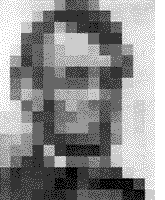 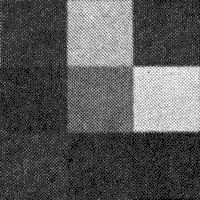 In November 1973, a researcher at Bell Labs named Leon Harmon wrote an article for Scientific American titled, "The Recognition of Faces." It includes several "block portrait" illustrations, most notably this one of Abraham Lincoln. He created the portraits with some prehistoric computer equipped with a "flying-spot scanner." Harmon used these pixelated portraits to test human perception and automatic pattern recognition. The article actually doesn't have the word "pixel" in it, but certainly introduced a new way of seeing. In November 1973, a researcher at Bell Labs named Leon Harmon wrote an article for Scientific American titled, "The Recognition of Faces." It includes several "block portrait" illustrations, most notably this one of Abraham Lincoln. He created the portraits with some prehistoric computer equipped with a "flying-spot scanner." Harmon used these pixelated portraits to test human perception and automatic pattern recognition. The article actually doesn't have the word "pixel" in it, but certainly introduced a new way of seeing.
|
| Salvador Dali - 1976
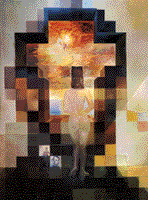 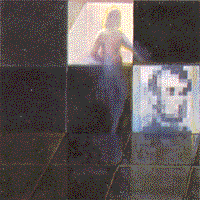 A few years after Harmon's article, Salvador Dali completed this painting titled, "Gala contemplating the Mediterranean Sea, which at 30 meters becomes the portrait of Abraham Lincoln (Homage to Rothko)." Not only did Dali appropriate Harmon's portrait of Lincoln into the overall composition, but Dali also reincorporated a smaller grayscale version into a single tile. A few years after Harmon's article, Salvador Dali completed this painting titled, "Gala contemplating the Mediterranean Sea, which at 30 meters becomes the portrait of Abraham Lincoln (Homage to Rothko)." Not only did Dali appropriate Harmon's portrait of Lincoln into the overall composition, but Dali also reincorporated a smaller grayscale version into a single tile.
|
| Rob Silvers - 1996
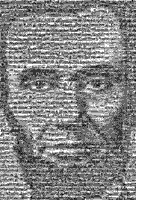 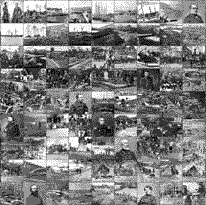 Rob Silvers began working on the first Photomosaics while he was a graduate student at the MIT Media Lab. Each tile in his images represents much more than a single value. The smaller pictures match the overall image in tone, texture, shape, and color. Silvers was commissioned by the US Library of Congress to create this portrait of Lincoln using archived photos of the American Civil War. Rob Silvers began working on the first Photomosaics while he was a graduate student at the MIT Media Lab. Each tile in his images represents much more than a single value. The smaller pictures match the overall image in tone, texture, shape, and color. Silvers was commissioned by the US Library of Congress to create this portrait of Lincoln using archived photos of the American Civil War.
|
| PhotoMontage - 1998
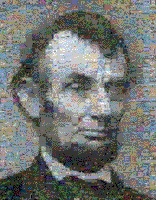 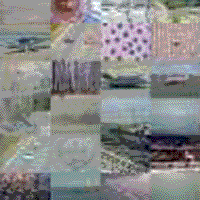 PhotoMontage is one of several commercial programs that became available around this time. This rendering was made with 960 tiles from a collection of 21,000 images off a photo CD. PhotoMontage is one of several commercial programs that became available around this time. This rendering was made with 960 tiles from a collection of 21,000 images off a photo CD.
|
| William Hunt - 1998
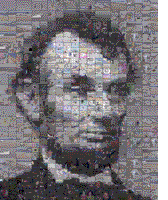 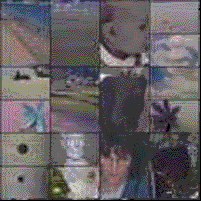 William Hunt is a computer programmer and insists that he is not doing this as an artist. He created this image using 554 tiles selected from his own personal database of about 5000 photos. He uses three different size tiles to change the look of the grid. Hunt's computer program, called PhotoTile, is available to download off his website. William Hunt is a computer programmer and insists that he is not doing this as an artist. He created this image using 554 tiles selected from his own personal database of about 5000 photos. He uses three different size tiles to change the look of the grid. Hunt's computer program, called PhotoTile, is available to download off his website.
|
| Scott Blake - 2001
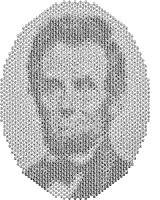 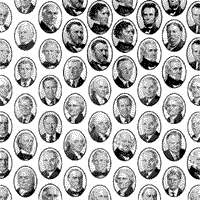 My Pixel President image of Abraham Lincoln is rendered using 42 portraits of all the US Presidents. I used a small collection of images to compromise the overall realism but increase the expressive impact. The small library of presidential portraits was downloaded from the Internet and standardized to match a unified setting. I arranged the presidents according to their grayscale density. So if a president had a full head of dark hair and wore a dark tie he would paint the dark areas in the mosaic and if he was balding and wore a white necktie he would paint the light areas. I offset the tiles on a beehive grid pattern to produce a hypnotic effect, and use the oval portraits to fill the space in a more efficient manner. Pixel President is about recycling useless information in an artistic way. My Pixel President image of Abraham Lincoln is rendered using 42 portraits of all the US Presidents. I used a small collection of images to compromise the overall realism but increase the expressive impact. The small library of presidential portraits was downloaded from the Internet and standardized to match a unified setting. I arranged the presidents according to their grayscale density. So if a president had a full head of dark hair and wore a dark tie he would paint the dark areas in the mosaic and if he was balding and wore a white necktie he would paint the light areas. I offset the tiles on a beehive grid pattern to produce a hypnotic effect, and use the oval portraits to fill the space in a more efficient manner. Pixel President is about recycling useless information in an artistic way.
|
|
Photos of Pixel President installation in Savannah, GA. |

